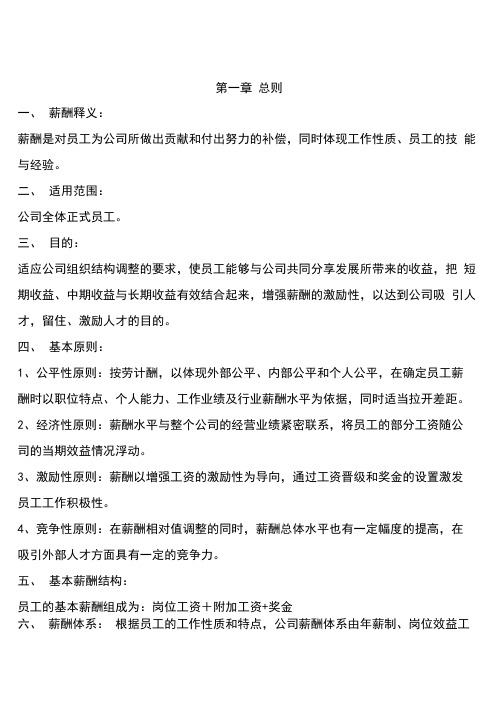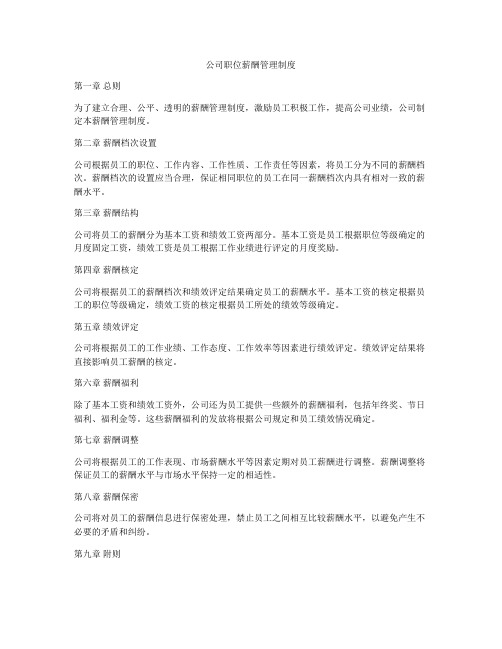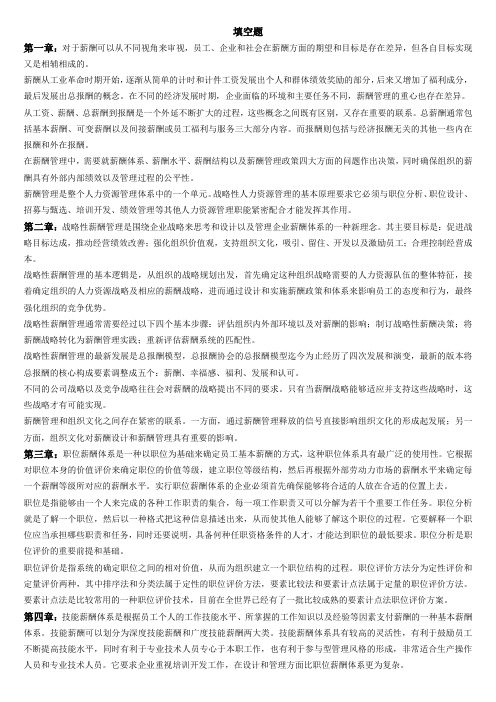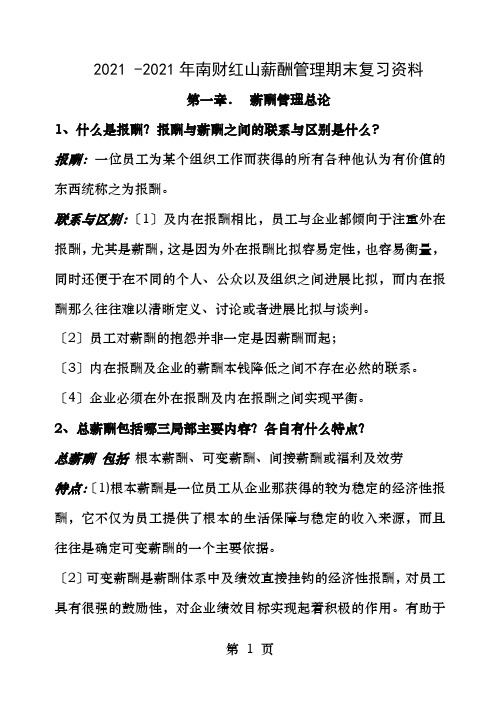第三章职位薪酬体系
薪酬管理第三章

(~2.00) (¥1.00)
35%
20%
(¥1.75) (¥1.00)
¥1.667 ¥1.167
合计
100% (¥5.00) 10096 (¥5.00)
100% (¥5.00)
¥ 5.000
步骤五:根据每个典型职位内部的每一报
酬要素的价值来分别对职位进行多次排序。
小时 心理 生理 技术 承担 工作 工资 要求 要求 要求 职责 条件
挑选典型职位。 确定职位评价方法。 建立职位评价委员会。 对职位评价人员进行培训。 对职位进行评价。 与员工进行交流,建立申诉机制。
二、排序法
(一)排序法的内涵及其分类 1.排序法是一种最简单的职位评价方法,它根据总
体上界定的职位的相对价值或者职位对于组织成功 所作出的贡献来将职位进行从高到低的排列。 2.排序法又可以划分成三种类型: 直接排序法 交替排序法以 配对比较排序法
懒惰的牧羊犬笑着说:“兄弟,牧羊人判断我们是否卖力 的标准是两个:一个是羊不能丢,二是看我们谁的舌头吐 得长。我这样跑两圈,累出很多汗,舌头自然会伸出来。 不像你,天天那么卖力,牧羊人回来的时候,舌头却伸不 长。哈哈!”
思考题: 牧羊人的问题出在哪里?如何改进?
第二节 职位评价与职位结构
一、职位评价简介 (一)职位评价的内涵及职位评价方法类型 所谓职位评价,就是指系统地确定职位之间的相对
(二)排序法的操作步骤 步骤一:获取职位信息 步骤二:选择报酬要素并对职位进行分类 步骤三:对职位进行排序 步骤四:综合排序结果 (三)排序法的优缺点 排序法最大的优点在于快速、简单、费用比较低,
而且容易和员工进行沟通。 排序法的缺点:在排序方面各方可能很难达成共识;
在评价过程中夹杂个人的主观意志甚至偏见;具 体的价值差距大小却无法得到明确的解释;在职 位的数量太多时排序法的使用难度会很高。
完整版岗位工资体系表

第一章总则一、薪酬释义:薪酬是对员工为公司所做出贡献和付出努力的补偿,同时体现工作性质、员工的技能与经验。
二、适用范围:公司全体正式员工。
三、目的:适应公司组织结构调整的要求,使员工能够与公司共同分享发展所带来的收益,把短期收益、中期收益与长期收益有效结合起来,增强薪酬的激励性,以达到公司吸引人才,留住、激励人才的目的。
四、基本原则:1、公平性原则:按劳计酬,以体现外部公平、内部公平和个人公平,在确定员工薪酬时以职位特点、个人能力、工作业绩及行业薪酬水平为依据,同时适当拉开差距。
2、经济性原则:薪酬水平与整个公司的经营业绩紧密联系,将员工的部分工资随公司的当期效益情况浮动。
3、激励性原则:薪酬以增强工资的激励性为导向,通过工资晋级和奖金的设置激发员工工作积极性。
4、竞争性原则:在薪酬相对值调整的同时,薪酬总体水平也有一定幅度的提高,在吸引外部人才方面具有一定的竞争力。
五、基本薪酬结构:员工的基本薪酬组成为:岗位工资+附加工资+奖金六、薪酬体系:根据员工的工作性质和特点,公司薪酬体系由年薪制、岗位效益工资制、销售提成工资制、计件工资制及协议工资制五种类型构成。
第二章岗位工资七、岗位工资是根据员工的岗位相对价值确定的工资单元。
八、岗位工资的分类:1、根据岗位工作性质,将公司的所有工作岗位进行分类,归入到服务及操作职工岗位、专业及技术职工岗位、主管岗位、部长岗位和高管岗位等五个职系。
九、员工岗位工资的确定:1、符合任职最低要求条件的员工工资,按所在职系职等对应岗位工资的最低档起薪。
2、学历条件与工作经验条件中一项高于任职要求而另一项低于任职要求的员工工资,按所在职系职等对应岗位工资的最低档起薪。
3、任职的学历条件或经验条件低于任职条件的员工工资,按所在职系职等对应岗位工资的最低档下调一级起薪。
4、符合任职条件,其中学历条件或工作经验条件高于任职要求的员工工资,按所在职系职等对应岗位工资的最低档上调一级起薪。
(完整版)薪酬管理

薪酬管理第一章总论重点概念:1.报酬:指组织成员从事组织所需要的劳动而获得的所有各种他认为有价值的东西.2.薪酬:薪酬仅仅包括货币性薪酬(基本薪酬和可变薪酬或浮动薪酬之和),而不包括福利。
3.福利:是员工的间接薪酬,一般包括非工作时间付薪、向员工个人及其家庭提供的服务、健康及医疗保健、人寿保险以及法定和企业补充养老金等。
4.薪酬管理:一个组织以所有员工所提供的服务为基础来确定他们应当得到的薪酬总额、薪酬结构以及薪酬形式的过程。
5.基本薪酬:一个组织根据员工所承担或完成的工作本身或者员工所具备的完成工作的技能或能力而向员工支付的相对稳定的经济性报酬.6.可变薪酬:与个人、群体或者组织绩效直接挂钩的经济性报酬,也称浮动薪酬或奖金.(短期、长期)7.间接薪酬:指非工作时间付薪、向员工个人或家庭提供服务、健康医疗保健、保险等。
8.全面薪酬:也称总薪酬,包括基本薪酬、可变薪酬、福利和服务以及一次性奖金、股票期权等多种经济性报酬。
9.全面报酬:①经济报酬②非经济报酬重点内容:1.★总薪酬的构成 P61)员工方面:①经济保障功能:满足劳动者及其家庭基本生活需要以及娱乐、教育、培训等方面的发展需要.②激励功能:可以满足员工不同层次的需要,并使员工通过薪酬状况的感知来影响行为、态度和绩效.③社会信号功能:以薪酬为标准体现员工工作能力和贡献,也代表了员工在组织内部的地位和层次,同时也说明了员工在社会上所处的位置。
2)企业方面:①促进战略实现,改善经营绩效②塑造和强化企业文化③支持企业变革④控制经营成本3)社会方面:①影响国民经济的正常运行②劳动力资源再配置3.★薪酬管理的主要内容 P22薪酬体系、薪酬水平、薪酬结构、薪酬形式、薪酬预算、控制、沟通薪酬体系:是指薪酬的构成,即一个人的工作报酬由哪几部分构成.一般而言,员工的薪酬包括以下几大主要部分:基本薪酬(即本薪)、奖金、津贴、福利四大部分。
薪酬水平:是指企业内部各类职位和人员平均薪酬的高低状况,它反映了企业薪酬的外部竞争性. 薪酬水平反映了企业薪酬相对于当地市场薪酬行情和竞争对手薪酬绝对值的高低。
公司职位薪酬管理制度

公司职位薪酬管理制度第一章总则为了建立合理、公平、透明的薪酬管理制度,激励员工积极工作,提高公司业绩,公司制定本薪酬管理制度。
第二章薪酬档次设置公司根据员工的职位、工作内容、工作性质、工作责任等因素,将员工分为不同的薪酬档次。
薪酬档次的设置应当合理,保证相同职位的员工在同一薪酬档次内具有相对一致的薪酬水平。
第三章薪酬结构公司将员工的薪酬分为基本工资和绩效工资两部分。
基本工资是员工根据职位等级确定的月度固定工资,绩效工资是员工根据工作业绩进行评定的月度奖励。
第四章薪酬核定公司将根据员工的薪酬档次和绩效评定结果确定员工的薪酬水平。
基本工资的核定根据员工的职位等级确定,绩效工资的核定根据员工所处的绩效等级确定。
第五章绩效评定公司将根据员工的工作业绩、工作态度、工作效率等因素进行绩效评定。
绩效评定结果将直接影响员工薪酬的核定。
第六章薪酬福利除了基本工资和绩效工资外,公司还为员工提供一些额外的薪酬福利,包括年终奖、节日福利、福利金等。
这些薪酬福利的发放将根据公司规定和员工绩效情况确定。
第七章薪酬调整公司将根据员工的工作表现、市场薪酬水平等因素定期对员工薪酬进行调整。
薪酬调整将保证员工的薪酬水平与市场水平保持一定的相适性。
第八章薪酬保密公司将对员工的薪酬信息进行保密处理,禁止员工之间相互比较薪酬水平,以避免产生不必要的矛盾和纠纷。
第九章附则本薪酬管理制度经公司管理层审定,将于颁布后正式实施。
公司将根据实际情况对薪酬管理制度进行修订和完善,以确保其能够有效地发挥激励员工的作用。
公司将根据员工的绩效评定结果和公司业绩情况,动态调整薪酬档次和薪酬结构,以促进员工的积极工作和公司的长期发展。
薪酬管理习题及答案2

填空题第一章:对于薪酬可以从不同视角来审视,员工、企业和社会在薪酬方面的期望和目标是存在差异,但各自目标实现又是相辅相成的。
薪酬从工业革命时期开始,逐渐从简单的计时和计件工资发展出个人和群体绩效奖励的部分,后来又增加了福利成分,最后发展出总报酬的概念。
在不同的经济发展时期,企业面临的环境和主要任务不同,薪酬管理的重心也存在差异。
从工资、薪酬、总薪酬到报酬是一个外延不断扩大的过程,这些概念之间既有区别,又存在重要的联系。
总薪酬通常包括基本薪酬、可变薪酬以及间接薪酬或员工福利与服务三大部分内容。
而报酬则包括与经济报酬无关的其他一些内在报酬和外在报酬。
在薪酬管理中,需要就薪酬体系、薪酬水平、薪酬结构以及薪酬管理政策四大方面的问题作出决策,同时确保组织的薪酬具有外部内部绩效以及管理过程的公平性。
薪酬管理是整个人力资源管理体系中的一个单元。
战略性人力资源管理的基本原理要求它必须与职位分析、职位设计、招募与甄选、培训开发、绩效管理等其他人力资源管理职能紧密配合才能发挥其作用。
第二章:战略性薪酬管理是围绕企业战略来思考和设计以及管理企业薪酬体系的一种新理念。
其主要目标是:促进战略目标达成,推动经营绩效改善;强化组织价值观,支持组织文化,吸引、留住、开发以及激励员工;合理控制经营成本。
战略性薪酬管理的基本逻辑是,从组织的战略规划出发,首先确定这种组织战略需要的人力资源队伍的整体特征,接着确定组织的人力资源战略及相应的薪酬战略,进而通过设计和实施薪酬政策和体系来影响员工的态度和行为,最终强化组织的竞争优势。
战略性薪酬管理通常需要经过以下四个基本步骤:评估组织内外部环境以及对薪酬的影响;制订战略性薪酬决策;将薪酬战略转化为薪酬管理实践;重新评估薪酬系统的匹配性。
战略性薪酬管理的最新发展是总报酬模型,总报酬协会的总报酬模型迄今为止经历了四次发展和演变,最新的版本将总报酬的核心构成要素调整成五个:薪酬、幸福感、福利、发展和认可。
第三章职位评价及职位等级设计

职位评价及职位等级设计1.第一节、职位薪酬体系及其职位分析基础1.1.职位薪酬体系的特点、实施条件和操作流程1.1.1.职位薪酬体系的特点及适用性•概念•职位薪酬体系,就是首先对职位本身的价值做出客观的评价,然后根据这种评价的结果赋予承担这一职位的人与该职位的价值相当的薪酬这样一种基本薪酬决定制度,•特点•最大的特点是员工担任什么杨的职位就得到什么杨的报酬。
在确定基本薪酬的时候,重点考虑职位本身的价值,很少考虑人的因素•假设基础•每一个职位上的人都是合格的,不存在任何职位不匹配的情况•优点•1、实现了真正意义上的同工同酬,可以说是一种真正的按劳分配体制•2、有利于按照职位系列进行薪酬管理,操作比较简单,管理成本低•3、晋升和基本薪酬的连带性增强了员工提高自身技能和能力的动力•4、根据职位支付薪酬的做法比基于能力和技能支付薪酬的做法更容易实现客观和公正,对职位的重要性进行评价要比对人的技能和能力进行评价更容易达成一致。
•缺点•1、由于薪酬与职位挂钩,当员工晋升无望时,也就没有获得大幅度加薪的机会,其工作积极性必然受过,甚至出现消极怠工或离职•2、由于职位相对稳定,与职位项链的薪酬也就相对稳定,不利于企业对多变饿外部经营环境做出迅速的反映,不利于及时激励员工•3、强化职位等级间的差距,可能会导致官僚主义滋生,更注重职位,而不是提升个人的工作能力和绩效水平,不利于提高员工的工作适应性•4、可能会引导员工更多的采取有利于得到职位晋升的行为,而不鼓励员工横向流动及保持灵活性。
1.1.2.实施职位薪酬体系的前提•1、职位的内容是否已经明确化、规范化和标准化,必须具备进行职位分析的基本条件•2、职位的内容是否基本稳定,在短期内不会有大的变动•3、是否具有按个人能力安排职位或工作岗位的机制•4、企业中是否存在相对较多的职级•5、企业的薪酬水平是否足够高1.1.3.职位薪酬体系设计的基本流程•1、了解一个企业的基本组织机构和职位在组织中的具体位置•2、收集与特定职位的性质有关的各种信息,进行职位分析•3、整理通过职位分析获得的各种信息,按照一定的格式把重要的信息描述出来并加以确认,编写成包括职位责任,任职资格条件等信息在哪的职位说明书•4、对典型职位的价值进行评价,完成职位评价工作•5、根据职位价值的相对高低进行排序,建立职位等级结构,同时也是薪酬的等级结构1.2.职位说明书1.2.1.职位的含义及相关概念•将职位或岗位界定为一位全日制员工在工作满负荷情况下需要完成的,具有一定内在联系且便于任职者完成各种职责及其相关工作任务的集合。
薪酬管理 第三章课后案例分析

人力0902 钱红香 0924062111、该集团公司实行的是职位薪酬体系吗?2、从该案例中可以看出该集团公司的薪酬体系设计存在哪些问题?答:1、是。
职位薪酬体系,就是首先对职位本身的价值作出客观的评价,然后根据这种评价的结果赋予承担这一职位的人与该职位的价值相当的薪酬这样一种基本薪酬决定制度。
在案例中,M集团公司是全国性的电信运营商,薪酬体系的基础是其职位体系,其职位体系在横向上划分为五个职位序列,在纵向上划分为七个职位层级,将公司的全部职位分为22个职位等级,职位等级的确定与职位本身的重要性和价值有关,与职位上任职人员个人的资历与能力无关。
这可以说明M集团公司是采用职位薪酬体系的。
2、存在的问题:(1)对于薪酬体系,该公司使用的是职位薪酬体系,它是一种比较传统的确定员工基本薪酬的制度,它最大的特点是员工担任什么样的职位就得到什么样的薪酬,它很少考虑人的因素。
故该公司员工的职位工资存在问题,不应该把综合补贴和绩效工资作为职位工资的一部分。
(2)对于M集团工资套改方案,该公司针对管理序列员工和非管理序列员工根据任职时间和工龄来修改,这个方法不符合职位薪酬体系中按照职位系列进行薪酬管理的要求,不符合按劳分配、同工同酬的特点,故该套改方案存在细节问题。
(3)附表3中,M集团公司专业序列职级对应关系差距过大。
一些专业的技术员、客户经理等职位等级过低,和高级资深经理之间的差距过大,打击员工的工作积极性,存在问题。
(4)附表5中,M集团公司各省分公司地区系数区间表,系数划分不够准确。
例如在表中它把江苏和西藏划分在同一系数区间0.87~1.15,这些地区的经济发展水平有差距不相近,但却被划分在同一系数区间内,故存在问题。
(5)附表2、附表3中,对应职级有重复交叉,不够明确,存在问题。
薪酬管理复习

2021 -2021年南财红山薪酬管理期末复习资料第一章.薪酬管理总论1、什么是报酬?报酬与薪酬之间的联系与区别是什么?报酬:一位员工为某个组织工作而获得的所有各种他认为有价值的东西统称之为报酬。
联系与区别:〔1〕及内在报酬相比,员工与企业都倾向于注重外在报酬,尤其是薪酬,这是因为外在报酬比拟容易定性,也容易衡量,同时还便于在不同的个人、公众以及组织之间进展比拟,而内在报酬那么往往难以清晰定义、讨论或者进展比拟与谈判。
〔2〕员工对薪酬的抱怨并非一定是因薪酬而起;〔3〕内在报酬及企业的薪酬本钱降低之间不存在必然的联系。
〔4〕企业必须在外在报酬及内在报酬之间实现平衡。
2、总薪酬包括哪三局部主要内容?各自有什么特点?总薪酬包括根本薪酬、可变薪酬、间接薪酬或福利及效劳特点:〔1)根本薪酬是一位员工从企业那获得的较为稳定的经济性报酬,它不仅为员工提供了根本的生活保障与稳定的收入来源,而且往往是确定可变薪酬的一个主要依据。
〔2〕可变薪酬是薪酬体系中及绩效直接挂钩的经济性报酬,对员工具有很强的鼓励性,对企业绩效目标实现起着积极的作用。
有助于企业强化个人、全体乃至公司优秀绩效,从而到达节约本钱。
提高产量、改善质量以及增加收益。
〔3〕员工福利或效劳,避税,退休不测提供了保障,调整员工购置力。
5、哪些是薪酬管理中最重要的管理决策?薪酬管理的原那么?重要决策:薪酬体系决策;薪酬水平决策;薪酬构造决策;薪酬管理政策决策。
薪酬管理原那么:〔对外竞争性、对内一致性〕①公平性原那么:内部、外部、过程、结果②竞争性原那么:薪酬水平领先、薪酬构造多元化、薪酬价值取向合理③鼓励性原那么:打破工资刚性,增强工资弹性,通过绩效考核,使员工的收入及公司业绩与个人业绩严密结合,激发员工积极性④经济性原那么:人力本钱的增长及企业总利润的增长幅度相对应,用适当工资本钱的增加引发员工创造更多的经济价值,可持续开展。
第二章. 战略性薪酬管理1、什么是战略性薪酬管理?战略性薪酬管理是以企业开展战略为依据,据企业某一阶段的内外部情况,正确选择薪酬策略、系统设计薪酬体系并实施动态管理,使之促进企业战略目标实现的一种机制。
薪酬管理-第三章-技能薪酬体系

服务业 运用单位生产或小批量生产技术的行业
技能薪资体系的应用情况
• 《财富》调查: 1985:8% ; 1993:60%
• 1998:《基于胜任力的薪酬体系》调查了334 名HR专家,1/3公司已采用,其中53%的员工认 为它受欢迎,5%认为它不受欢迎
• 根据每一工作任务类别所代表任务类型以命名,即得不同等 级的技能,又称技能等级模块。
3、技能等级的确定与定价
工作任务——知识——能力——技能——胜任能力 工作任务——用来说明一位员工需要做什么、为什么要做、
如何做以及在哪里做的书面任务描述。 知识——是指人的能力和技能发挥作用的必要的信息性基础。 能力——是指一位员工完成工作的实际能力。 技能——是能力概念的一种延伸,包括了一种绩效标准。 胜任能力——是技能改变的一种变形,它与技能之间的差异主 要存在于应用的职业范围不同,前者适用于蓝领和事务性人 员,后者管理、专业人员、技术人员和白领。
• 加拿大两家企业:1998年Murry和Gerhart考察 37个月 已采用的企业: 生产率:提高58% 劳动成本降低16% 废品减少82%
• 管理层与员工保持紧密合作的长期关系 • 复杂程度高、技术密集的企业与组织 如:高新企业、研发机构、学校 • 具有有机的组织形式的企业或组织 • 支撑体系——工作设计
技能薪酬体系强调员工掌握多种不同的工作能力,而不是 严格与本职工作相对应,因此,需要工作设计体系以辅之。
• 与职位薪酬体系配套的传统工作设计方式
员工1
员工2 员工3
员工4
工作A
工作B
工作C
工作D
与技能薪酬体系配套的新工作设计方式
薪酬管理基本知识

《薪酬管理》复习提纲第一章薪酬管理总论1.市场经济在本质上是一种交换经济。
通常情况下,我们将一位员工因为为某个组织工作而获得的所有各种他认为有价值的东西统称为报酬。
2.我们用两种不同的方式来对报酬进行分类,一种方法是将报酬划分为经济报酬和非经济报酬;另一种方法是将报酬划分为内在报酬和外在报酬。
3.薪酬在本质上正是雇主或企业为获取员工所提供的劳动而提供的一种回报或报酬。
4.对于薪酬概念的界定,通常分为三类:①宽口径的界定,即将薪酬等同与报酬,即员工由于完成了工作而获得的各种内在报酬和外在报酬②中等口径的界定,即员工因为雇佣关系的存在而从雇主那里获得的各种形式的经济收入以及有形服务和福利③窄口径的界定,即薪酬仅仅包括货币性薪酬,而不包括福利。
5.企业通常把薪酬和福利两部分成为总薪酬或总薪酬包。
将薪酬称为直接薪酬,福利称为间接薪酬。
直接薪酬划分为基本薪酬和可变薪酬两大部分。
6. 总薪酬或全面薪酬包括基本薪酬、可变薪酬、福利和服务以及一次性奖金、股票期权等多种经济性报酬。
7.基本薪酬是指一个组织根据员工所承担或完成的工作本身或者员工所具备的完成工作的技能或能力而向员工支付的相对稳定的经济性报酬。
基本薪酬在很多时候又被称为“薪酬”或“固定薪酬”8. 可变薪酬是薪酬体系中与绩效直接挂钩的经济性报酬,有时也被称为浮动薪酬获奖金。
可变薪酬分为短期可变薪酬和长期可变薪酬两种。
9.绩效加薪和可变薪酬都与员工的绩效联系在一起。
10.员工福利或服务不是以员工为企业工作的时间为计算单位的,它一般包括非工作时间付薪、向员工个人及家庭提供服务、健康及医疗保健、人寿保险以及法定和企业补充养老金。
11.薪酬的功能:员工方面:①经济保障功能②激励功能③社会信号功能企业方面:①促进战略实现,改善经营绩效②塑造和强化企业文化③支持企业改革④控制经营成本12.薪酬概念的发展经历了工资、薪酬、全面薪酬或总薪酬以及全面报酬四个阶段的变化。
13.20世纪初,科学管理运动的开创者W·泰勒提出了差别计件工资计划。
薪酬管理习题(第1-5章)

第一章薪酬管理概述一、填空题1。
薪酬的核心部分包括三个板块:基本薪酬、奖金和__ _。
2.为确保公司支付给员工的薪酬有外部竞争力,在进行薪酬设计时要进行。
3.__ _ 是对于完成的超额、超标准的绩效进行奖励,对于预定的绩效目标进行激励。
4.企业薪酬管理的内容包括了薪酬战略、______、薪酬政策和______。
5。
薪酬管理的公平性可以有不同的观察视角,如程序公平和________,内部公平和________.6.基本薪酬的确定的四种基本方式:、基于能力的薪酬、基于绩效的薪酬和__ __。
7.企业的薪酬管理一般要实现、有效性和合法性三大目标。
薪酬管理的原则中指企业的薪酬管理系统和管理过程是否符合国家的相关法律规定。
8。
薪酬对于员工的功能有_____、_____、_____。
二、选择题1.通常是指雇主为已经完成的工作而向雇员支付的货币薪酬()A.绩效薪酬 B。
基本薪酬 C。
福利薪酬 D.奖金薪酬2。
以规则和规章的形式表现的组织的薪酬决策、薪酬分配标准和管理方式()A。
薪酬制度 B。
薪酬技术 C。
薪酬支付 D薪酬预算3.“同一企业中担任相同职位的员工,其所获得的薪酬应与其贡献相匹配。
”这句话体现了薪酬公平原则中所包含的( )公平。
A.绩效报酬 B。
职位价值 C。
要素价值 D。
内在报酬4.国家通过强制手段规定用人单位支付给劳动者的工资下限,以满足劳动者自身及其家庭成员基本生活需求的法律制度( )A 。
最低工资 B.标准工资 C .平均工资 D.社平工资5。
带薪非工作时间属于_______中的一种形式。
( )A。
基本薪酬 B.津贴 C.可变薪酬 D。
间接薪酬6。
薪酬模块中具有高差异性和低刚性的是( )A。
奖金 B。
福利C。
保险D。
基本薪酬7。
在以下薪酬主要构成模块中,具有高差异性和高刚性的是( )A。
基本薪酬 B。
奖金 C.保险 D。
福利8.下列属于间接薪酬的项目是( )A。
基本工资 B。
非工作时间的付酬 C.奖金 D.津贴9。
第三章职位薪酬体系

2020/11/18
版权所有 翻录必究
开篇案例
思考:
平均主义不公平 ? 市场比较不公平 ? 差距不合理不公平 ? 模糊工资不公平 ? 谈判工资不公平 ? 如何体现公平?
2020/11/18
版权所有 翻录必究
职位薪酬体系
① 职位薪酬体系的特点与操作流程 ② 工作分析与职位说明书的编写 ③ 职位评价——排序法 ④ 分类法 ⑤ 要素比较法 ⑥ 要素计点法
2020/11/18
基于职位(Position)
基于能力(Person) 或技能
基于绩效(Performance)
版权所有 翻录必究
职位薪酬体系的特点与操作流程
2020/11/18
版权所有 翻录必究
职位薪酬体系的特点与操作流程
职位薪酬体系,是分析职位的付酬因素, 比较职位的相对价值,确定职位的高低顺 序,根据职位条件确定合适任职人选,根 据职位价值确定任职人员的薪酬的程序和 方法体系。薪随岗定,岗动薪变。。
monitor, leader)
2020/11/18
版权所有 翻录必究
工作分析和职位说明书的编写
Job Analysis -Data Related to Employee
Employee Characteristics Professional/technical knowledge Manual skills Verbal skills Written skills Quantitative skills Mechanical skills Conceptual skills Managerial skills Leadership skills Interpersonal skills
Employee Characteristics Internal Relationships External Relationships
薪酬管理考试重点

薪酬管理第一章薪酬和薪酬管理一,薪酬的概念广义:我们将一位员工因为为某一组织工作而获得的所有各种他认为有价值的东西统统称之为报酬,也称360度报酬。
(1)可将其划分为经济性报酬和非经济性报酬(包括主要内容)(2)从报酬本身对工作者产生的激励来看,分为外在报酬和内在报酬狭义:薪酬就是指员工因为雇佣关系的存在而从雇主那是获得的所有各种形式的经济收入以及有形服务和福利。
分为三部分:基本薪酬,可变薪酬,间接薪酬;1,基本薪酬指一个组织根据员工所承担或完成的工作本身或者是员工所具备的完成工作的技能和能力而向员工支付的稳定性报酬。
绩效加薪:它是一种用来承认员工过去的令人满意的工作行为以及业绩的基本薪酬增长方式。
2,可变薪酬指薪酬系统中与绩效直接挂钩的部分,有时也被称为浮动薪酬或奖金绩效加薪和可变薪酬的区别:3指员工福利与服务。
它不是以员工向企业供给的工作时间为单位来计算的薪酬组成部分。
包括:带薪非工作时间、员工个人及家庭服务、健康及医疗保健、人寿保险等等。
3.1福利指企业为了保障员工的基本生活而对员工提供经济上的帮助、生活上的便利以补充员工基本的、经常的、共同的或特殊的生活而采取的福利措施和举办的福利事业的总称。
(分为强制性福利和企业自愿福利)4.薪酬的功能:对员工:1,经济保障功能;2,心理激励功能;3,社会信号功能;对企业:1.控制经营成本;2改善经营绩效;塑造和强化企业文化;支持企业变革。
二:薪酬管理:1,薪酬管理的含义指在企业经营实践过程中,在特定组织宏观战略指导下,为了吸引、激励员工,达成组织目标,而对本企业薪酬支付标准、薪酬水平、薪酬结构等进行设计、调整和确定的动态管理过程。
公平性、有效性和合法性三大目标。
(1)公平性:涉及到员工本人薪酬与企业外部劳动力薪酬的公平性、与企业内部不同职位上人员薪酬的公平性、与企业内部类似职位上人员的公平性。
公平性:外部竞争性;内部公平性;绩效报酬公平性;薪酬管理过程的公平性。
中国人民大学HR《薪酬管理》刘昕

中国人民大学HR《薪酬管理》刘昕薪酬管理第一章:薪酬管理总论第二章:战略性薪酬管理第三章:职位薪资体系第四章:技能与能力薪资体系第五章:外部竞争性第六章:薪资结构第七章:绩效奖励与认可第八章:福利第九章:特殊群体报酬第十章: 预算与沟通第一章薪酬管理总论开篇案例(1-1)开篇案例(1-2)开篇案例(1-3)开篇案例(1-4)第一节薪酬的相关概念及主要功能薪酬的演变过程什么是报酬?什么是薪酬?总报酬的构成薪酬的功能薪酬发展简史第二节薪酬管理及其面临挑战薪酬管理与其它人力资源管理职能之间的关系薪酬管理的重要内容及其决策薪酬管理中的若干重要决策薪酬管理的基本流程第二章薪酬的战略性管理开篇案例-中国电信的薪酬体制改革(4-1) 开篇案例-中国电信的薪酬体制改革(4-2) 开篇案例-中国电信的薪酬体制改革(4-3) 开篇案例-中国电信的薪酬体制改革(4-4) 第一节战略性薪酬管理与企业战略战略性薪酬决策的内容战略性薪酬管理与企业竞争力战略性薪酬管理对人力资源管理职能的新要求薪酬战略与公司战略的匹配创新者的经营战略与薪酬战略成本领袖的经营战略与薪酬战略以客户为中心者的经营战略与薪酬战略第二节从传统薪酬战略到全面报酬战略传统薪酬存在的一些问题全面薪酬管理战略的基本理念全面薪酬的构成:基本薪酬全面薪酬的构成:可变薪酬全面薪酬的构成:福利全面薪酬战略的内涵或特征全面薪酬战略的内涵或特征 IBM的薪酬战略支持其新战略(3.1) IBM的战略与文化转型及其薪酬制度改革(3.2)IBM的战略与文化转型及其薪酬制度改革(3.3) IBM的战略与文化转型及其薪酬制度改革(3.4)面向21世纪的全面报酬战略 Towers Perrin公司的全面报酬体系合益公司(Hay Group)的全面报酬体系 2000年美国与加拿大薪酬协会的全面报酬模型美国全面报酬学会的全面报酬体系模型(2006)第三章职位薪资体系开篇案例―人才价格到底谁说了算(1.1) 开篇案例―人才价格到底谁说了算(1.2) 第一节职位薪资体系与职位分析职位薪酬的特点实施职位薪资体系的前提条件职位薪资体系设计的基本流程职位分析的含义职位说明书的编写第二节职位评价技术职位评价的定义及其作用职位评价的基本方法职位评价方法分类排序法的定义及其类型直接排序法举例交替排序法举例配对比较法排序法的评价分类法:定义分类法举例:某工程公司分类法:优点与缺点计点法计点方案的设计步骤报酬要素定义及其重要意义报酬要素举例报酬子要素定义(2.1)报酬子要素定义(2.2)报酬子要素等级定义:自主性报酬要素权重的确定报酬要素权重的确定方法报酬要素等级点数确定公式举例:报酬要素等级的点数确定(3.1)举例:报酬要素等级的点数确定(3.2)举例:报酬要素等级的点数确定(3.3)基准职位的选取计点法评价方案举例 XX公司职位评要素定义与分级19-2 XX公司职位评要素定义与分级19-11 某公司职位评价(工人岗):报酬要素的分级典型的职位评价方案-美国Hay Group职位评价体系知识要素评价模板解决问题的能力要素评价模板应负责任要素评价模板 Hay职位评价系统的优缺点典型的职位评价方案-美世(Mercer)公司职位评价系统美世公司职位评价系统 -美国联邦政府9要素职位评价体系美国联邦政府职评价系统的职位等级划分计点法的优缺点要素比较法三种常用职位评价方法的比较传统职位评价的特点新薪资战略的职位评价特点第四章技能能力薪资体系开篇案例―同工不同酬的苦恼(3-1)开篇案例―同工不同酬的苦恼(3-2)开篇案例―同工不同酬的苦恼(3-3)第一节技能薪资体系技能薪资的内涵技能薪资体系的基本类型(2-1)深度技能薪资计划例子技能薪资体系的基本类型(2-2)广度技能薪资计划例子技能薪酬与工作设计:保险公司案例技能薪资体系的优点技能薪资体系的不足设计技能薪资体系的几个关键决策技能薪资体系的设计流程技能分析技能薪酬操作要点(3.1)技能薪酬操作要点(3.2)技能薪酬操作要点(3.3)某公司技术人员技能薪酬计划(2.1)某公司技术人员技能薪酬计划(2.2)第二节能力薪资体系能力的基本概念麦克里兰能力词典能力模型的类型通用电气公司人力资源能力模型能力薪资计划设计的前提能力模型及薪资建立的基本流程能力与能力薪资挂钩的几种方案三大薪资体系的比较以职位为基础的薪酬结构(2.1)以职位为基础的薪酬结构(2.2)以技能为基础的薪酬结构(2.1)以技能为基础的薪酬结构(2.2)以能力为基础的薪酬结构(2.1)以能力为基础的薪酬结构(2.2)开篇案例―联想的薪酬就这样和国际接轨(3-1)开篇案例―联想的薪酬就这样和国际接轨(3-2)开篇案例―联想的薪酬就这样和国际接轨(3-3)第一节薪酬水平及其外部竞争性决策薪酬水平及外部竞争性的作用竞争性薪酬政策选择之一:领袖政策调整数据以反映组织薪资水平政策:领袖政策竞争性薪酬政策选择之二:追随政策调整数据以反映组织薪资水平政策:追随政策竞争性薪酬政策选择之三:拖后政策调整数据以反映组织薪资水平政策:拖后政策竞争性薪酬政策选择之四:混合政策第二节薪酬水平决策的主要影响因素外部竞争性与劳动力市场相关劳动力市场的界定外部竞争性的影响因素劳动力需求理论及其启示劳动力供给理论及其启示产品市场对企业薪酬水平的影响企业特征要素对薪酬水平的影响第三节市场薪酬调查薪酬调查的定义与作用薪酬调查的实施步骤薪酬调查中需要搜集的信息类型薪酬调查问卷节选(3.1)薪酬调查问卷节选(3.2)薪酬调查问卷节选(3.3)薪酬调查数据的分析薪资调查数据分析:频度分析开篇案例―某广告公司的薪酬规定(4-1)开篇案例―某广告公司的薪酬规定(4-2)开篇案例―某广告公司的薪酬规定(4-3)开篇案例―某广告公司的薪酬规定(4-4)第一节薪资结构设计薪资结构确定的流程薪酬变动区间与变动比率不同职位类型及其薪酬变动比率不同薪酬变动比率所产生的影响薪资比较比率不同薪资比较比率设计对薪资差距的影响通过薪资区间变动比率与区间渗透度分析员工的长期薪资变化薪资等级设计举例薪酬区间中值级差/区间变动比率/区间重叠(2.1)薪酬区间中值级差/区间变动比率/区间重叠(2.2)薪资结构设计的步骤薪资结构设计的步骤(6.1)薪资结构设计的步骤(6.2)薪资结构设计的步骤(6.3)薪资结构设计的步骤(6.4)薪资结构设计的步骤(6.5)薪资结构设计的步骤(6.6)第二节薪资宽带何谓“薪资宽带”?传统薪资等级制与薪资宽带职位薪资体系下的宽带薪资结构宽带薪资的特征和作用传统薪资结构与宽带薪资结构的综合比较薪资结构设计的几个关键决策薪资宽带内部的差异性定价实施宽带薪资结构的几个要点通用电气零售商财务服务公司薪资宽带:一级通用电气零售商财务服务公司薪资宽带:三级通用电气零售商财务服务公司薪资宽带:五级第七章绩效奖励与认可计划计划开篇案例(2-1)开篇案例(2-2)第一节绩效激励的基本原理综合激励理论激励理论:马斯洛需求层次论激励理论:赫兹伯格双因素论激励理论:期望理论激励理论:公平理论激励理论:强化理论激励理论:目标管理理论激励理论:代理理论绩效奖励计划内涵绩效奖励计划:起源与作用绩效奖励计划的优点与缺点绩效奖励计划的实施要点第二节绩效奖励计划的种类绩效奖励计划的类型基本薪酬增加与绩效加薪简单绩效加薪市场化绩效加薪以绩效和相对薪酬水平为基础的绩效加薪基于薪资比较比率的绩效加薪以绩效、相对薪酬水平及时间为基础的加薪计划月/季度浮动薪酬月/季度浮动薪酬(奖金)的确定特殊绩效认可计划案例个人奖励计划的内涵及实施条件个人绩效奖励计划的优点个人奖励计划的缺点个人绩效奖励计划---直接计件工资计划个人绩效奖励计划---标准工时计划个人奖励计划---差额计件工资计划个人奖励计划:海尔塞(Halsey)计件工资计划个人奖励计划:罗曼/甘特计件工资计划群体奖励计划的适应情况群体奖励计划的优缺点利润分享计划:概念与形式利润分享计划的缺点收益分享计划:概念及其与利润分享的区别收益分享计划的优点第一代和第二代收益分享计划(3.1)第一代和第二代收益分享计划(3.2)第一代收益分享计划---斯坎伦计划(3.3)第三代收益分享计划的优点何谓成功分享计划?成功分享计划中的实施要点成功分享计划的设计程序成功分享计划举例一次性奖金决定矩阵长期奖励计划(3.1)长期奖励计划(3.2)长期奖励计划(3.3)股票所有权计划的类型美国股票期权计划的类型长期奖励计划案例之一长期奖励计划案例之二我国企业的股权激励计划员工持股计划的典型内容中国的员工持股计划所面临的困境第三节特殊绩效认可计划特殊绩效认可计划(4.1)特殊绩效认可计划(4.2)特殊绩效认可计划对组织报酬战略的贡献(4.3)特殊绩效认可计划(4.4)特殊绩效认可计划的设计与实施第八章员工福利管理开篇案例―远行公司企业年终福利计划策略 (5.1) 开篇案例―远行公司企业年终福利计划策略 (5.2) 开篇案例―远行公司企业年终福利计划策略 (5.3) 开篇案例―远行公司企业年终福利计划策略 (5.4) 开篇案例―远行公司企业年终福利计划策略 (5.5) 第一节员工福利概论员工福利特征员工福利的影响员工福利方面存在的问题员工福利的发展趋势第二节员工福利的种类员工福利的种类员工福利:法定保险员工福利:法定假期员工福利:住房公积金员工福利:企业补充保险员工福利:员工服务福利弹性福利计划―内涵弹性福利计划―实施方式第三节员工福利的规划与管理提供什么样的福利为谁提供福利福利福利管理―处理福利申请福利管理―福利沟通福利管理―福利监控第九章特殊员工群体薪酬管理开篇案例―IT企业的薪酬激励(4.1) 开篇案例―IT企业的薪酬激励(4.2) 开篇案例―IT企业的薪酬激励(4.3) 开篇案例―IT企业的薪酬激励(4.4) 第一节销售人员的薪酬管理销售人员薪酬方案:纯佣金制销售人员薪酬方案:基本薪酬+佣金销售人员薪酬计划:基本薪酬+间接佣金销售人员薪酬计划:基本薪酬+奖金1 销售人员薪酬计划:基本薪酬+奖金2 销售人员薪酬计划:基本薪酬+奖金3 销售人员薪酬计划:基本薪酬+佣金+奖金销售人员薪酬方案的设计步骤销售人员薪酬方案的设计团队中角色评估现有的薪酬计划设计新的薪酬方案执行新的薪酬方案评价新的薪酬方案第二节专业技术人员的薪酬管理专业技术人员的成熟曲线以及薪酬决定专业人员的双重职业/薪酬通道专业人员的薪酬结构第三节外派员工的薪酬管理外派员工的定义企业国际化的不同阶段以及外派政策外派员工的定价方式几种不同外派方式的薪酬决定方式第四节管理人员的薪酬管理管理人员的薪酬管理高层管理者的薪酬管理―薪酬构成高层管理者的薪酬管理―薪酬战略第十章薪酬预算、控制与沟通开篇案例―沃尔玛薪酬制度转型(6.1) 开篇案例―沃尔玛薪酬制度转型(6.2) 开篇案例―沃尔玛薪酬制度转型(6.3) 开篇案例―沃尔玛薪酬制度转型(6.4) 开篇案例―沃尔玛薪酬制度转型(6.5) 开篇案例―沃尔玛薪酬制度转型(6.5) 第一节薪酬预算薪酬预算的内涵薪酬预算的目标薪酬预算过程中的一些关键决策薪酬预算环境―外部环境薪酬预算环境―内部环境薪酬预算环境―成活成本的变动薪酬预算环境―企业现有的薪酬状况酬预算的方法―宏观接近法(4.1)宏观接近法―根据薪酬费用比率推算合理的薪酬费用总额宏观接近法―根据盈亏平衡点推断适当的薪酬费用比率(2.1)宏观接近法―根。
- 1、下载文档前请自行甄别文档内容的完整性,平台不提供额外的编辑、内容补充、找答案等附加服务。
- 2、"仅部分预览"的文档,不可在线预览部分如存在完整性等问题,可反馈申请退款(可完整预览的文档不适用该条件!)。
- 3、如文档侵犯您的权益,请联系客服反馈,我们会尽快为您处理(人工客服工作时间:9:00-18:30)。
PAY STRUCTURE
CONTRIBUTORS
Seniority Performance Merit
INCENTIVE
based
based
guidelines PROGRAMS
EFFICIENCY • Performance • Quality • Customers • Stockholders • Costs
工作分析和职位说明书的编写
Job Analysis -Data Related to Job
Job Identification
Title
Department in which job is located
Number of people who hold job
Job Content Tasks Activities Constraints on actions Performance criteria Critical incidents Conflicting demands Working conditions Roles (e.g., negotiator,
POLICIES
TECHNIQUES
OBJECTIVES
ALIGNMENT
Work Descriptions Evaluation/ INTERNAL
analysis
certification STRUCTURE
COMPETITIVENESS
Market Surveys definitions
Policy lines
Level of analysis
Broad vs. narrow Affected by several factors
Time and expense of collecting data Need for flexibility in designing jobs Need to provide promotional opportunities
职位薪酬体系的特点与操作流程
职位薪酬体系的优点: 实现同工同酬,实行职位序列管理,可操作性强,基 本薪酬有保障,促进员工职位进取和竞争。
缺点: 职位晋升才有薪酬变化,薪酬相对固定化,对外界变 化不够敏感,限制员工的积极性,容易产生懈怠情绪 和主动离职。
职位薪酬体系的特点与操作流程
实施职位薪酬体系的前提条件:
Job analysis
Job descriptions
Job evaluation
Job structure
Collecting information about the nature of specific jobs
Summary reports that identify, define, and describe the job as it is actually performed
OTHERS’ PAY Their qualifications Their work performed Their product value
职位薪酬体系的特点与操作流程
内部公平所需解决问 题:
• 确定基本工资的 支付基础(3P)
• 正确测度支付基 础
• 根据测度结果设 计薪酬体系
基于职位(Position)
FAIRNESS
MANAGEMENT
Costs Communication Change EVALUATION
COMPLIANCE
职位薪酬体系的特点与操作流程
薪酬体系设计的两大主题:
确保薪酬水平对外特别是与竞争对手相比具有竞争力 确保对内相对公平
MY PAY My qualifications My work performed My product value
职位内容明确化、规范化和标准化 职位内容的相对稳定性 严格任职资格和任职程序 职位级别层次较多,能够逐步提升 薪酬水平比较高,能够保证在职人员的基本薪酬待遇
职位薪酬体系的特点与操作流程
基于职位的薪酬体系设计:
工作分析 薪酬调查
职位评价 薪酬水平
基于职位 薪酬体系
职位薪酬体系
① 职位薪酬体系的特点与操作流程 ② 工作分析与职位说明书的编写 ③ 职位评价——排序法 ④ 分类法 ⑤ 要素比较法 ⑥ 要素计点法
Comparison of jobs within an organization
An ordering of jobs based on their content or relative value
Some Major Issues in Job Analysis • Why collect information? • What information is needed? • How to collect the information? • Who should be involved? • How useful are the results?
工作分析和职位说明书的编写
Why Perform Job Analysis?
Potential uses for job analysis exist for every major human resource function
An internal structure provides a work-related rationale for pay differences
基于能力(Person) 或技能
基于绩效(Performance)
职位薪酬体系的特点与操作流程
职位薪酬体系的特点与操作流程
职位薪酬体系,是分析职位的付酬因素 ,比较职位的相对价值,确定职位的高低 顺序,根据职位条件确定合适任职人选, 根据职位价值确定任职人员的薪酬的程序 和方法体系。薪随岗定,岗动薪变。。
开篇案例
此后,公司里关于薪酬收入的小道消息满天飞,员工c、d、e通过一些 非正式的渠道也都彼此知道了各自工资和年终奖的数额。在 L公司开始赢利 后的第一年(公司成立后第三年),公司员工针对薪酬待遇的抱怨之声四起 ,积极性开始下降,不时有人跳槽,迟到早退现象也不断增加,生产率随之 大幅下跌。与此同时,竞争对手向市场推出了同类型的竞争性产品,已极大 地威胁到 L 公司的市场地位。
工作分析和职位说明书的编写
Job Analysis Terminology
JOB FAMILY Grouping of related jobs with broadly similar content, e.g. marketing, engineering, office support, technical.
第三章职位薪酬体系
2020年7月25日星期六
开篇案例
L 公司是国有企业A 集团下属的一个分公司,主要从事高科技电子产品 的研发与生产。L公司是由A集团原来的 V 子公司与J子公司组建而成,组建 时员工主要来自V公司和J公司。同时,为了发展需要,公司还从人才市场 招聘了一部分员工。
公司运营后,来自V公司的员工c的工资依然按照V公司原来的薪酬标准 发放,来自J公司的员工d的工资仍然按照J公司原来的薪酬标准发放,而从 外部人才市场招聘来的员工e则按市场标准发放工资。L公司的薪酬均以月 固定工资的形式发放,实行薪酬保密制度。员工c、d、e 担任的工作任务都 是电路 设计与研发,然而员工e 的工资却远多于 c,而c又略多于 d。 由于 L公司生产的产品处于国内领先水平,A 集团对其非常重视。在L公司 成立之初,L公司总经理(兼任 A集团副总 裁)就曾向员工许诺,公司赢利 后将逐步提高员工的薪酬待遇。L公司员工的积极性因此非常高涨,在较短 的时间内,完成了多个研发项目,并顺利通过评审。产品投放到市场后, 公司逐渐 开始赢利,而薪酬制度却仍然没有变动,公司的总经理只是在 年末以非公开的形式发放了年终奖。
Uses of job analysis in compensation
Establishes similarities and differences in work content of jobs
Helps establish an internally fair and aligned job structure
工作分析和职位说明书的编写
Information to be Collected: Other Issues
Essential elements and Americans with Disabilities Act (ADA)
Requires that essential elements of a job must be specified
What Information Should be Collected?
Analysis begins with a review of information already collected
Types of information collected
Related to job Related to employee
monitor, leader)
工作分析和职位说明书的编写
Job Analysis -Data Related to Employee
Employee Characteristics Professional/technical knowledge Manual skills Verbal skills Written skills Quantitative skills Mechanical skills Conceptual skills Managerial skills Leadership skills Interpersonal skills
JOB Group of tasks performed by one person that make up the total work assignment of that person, e.g. customer support representative.
